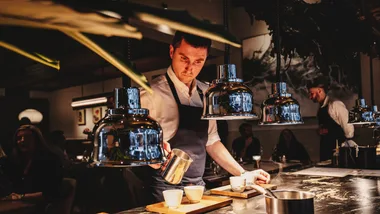John Susman from Fishtales gives us his tips to sailing the high seas of seafood cooking.
What seafood holds up the best in braises, soups and stews, John?
The key to getting the most out of your seafood in winter warmer-type dishes is to consider the preparation in several different stages.
Prepare the base of your dish first using the shells, frames and heads of crustaceans and fish.
Roast them with your core vegetables and when they’re nicely browned and aromatic, add wine and water to quickly cook out their flavour. Once cooked (it will take less than an hour), all that’s required is to push the lot through a food mill and strain.
This base can now be used to cook pulses, grains, pasta or other root vegetables. Next step is to add the prepared seafood. Oily fish such as mackerel, tuna and salmon work especially well in wet preparations. Have the fishmonger cut a classic tronçon or cutlet; the centre bone will hold the flesh together and also add great flavour. Blue eye, hapuku and snapper are also great, but be sure to choose thick cuts and leave the skin on – when cooked gently, it will go silky smooth and turn up the flavour dial. Prawns, bugs, crab and lobster all work especially well, too, but warm crustaceans through gently to avoid toughening the delicate meat.
Try our crab recipes.
Mussels, oysters and clams can be popped in at the last minute – their brininess is like self-seasoning. Seafood loves fresh herbs and lemon juice to finish, too. It’ll add sunshine to even the darkest day.










